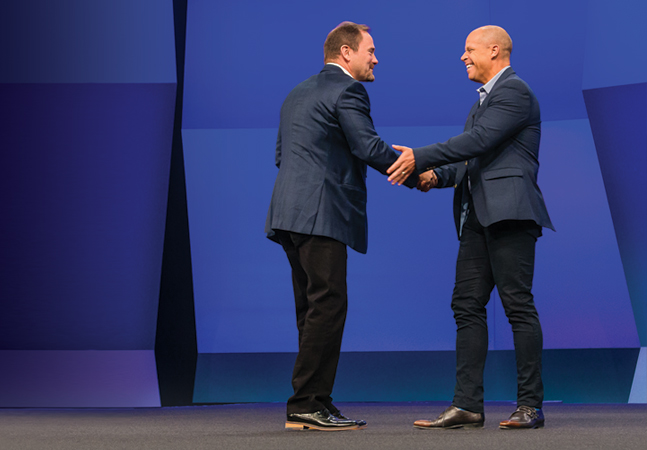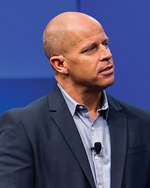In-Depth
Microsoft and Citrix Solidify Deep Friendship
Microsoft's most enduring partnership with Citrix is now more extensive than ever.

For the first time IT organizations will be able to provision virtual instances of Windows 10 as a service from the Microsoft Azure public cloud using their existing software licenses. The Windows 10 as a service will arrive via the Citrix XenDesktop virtual desktop infrastructure (VDI) offering. The companies haven't said when the service will be available, but it appears they're aiming to have a technical preview out later this year. It's a significant move for Microsoft, which to date has never permitted anyone to offer Windows as a service under the existing end-user license agreement. The new agreement between Microsoft and Citrix Systems Inc. -- which eliminates the need for back-end infrastructure while using existing Windows licenses -- is just one of many new ways the two companies are going to help each other out. In what officials at both companies called their most significant partnership to date, they will also deliver Office 365 and Skype for Business as virtual applications via Citrix XenApp, share features among both companies' respective enterprise mobility and management suites, and bring features of Citrix ShareFile to Office 365 and SharePoint Online.
Ties between the two companies date back 25 years when Microsoft's then-CEO and Founder Bill Gates, joined by Intel Corp. and venture capital firm Kleiner Perkins, invested in Citrix. Several years later, Citrix and Microsoft entered into their first of many licensing agreements that would give Citrix the source code to Windows, allowing it to initially create a multi-user OS and, ultimately, become the leading provider of thin-client computing technology.
A push for change in hopes of fueling faster growth was led by activist hedge fund investor Elliott Management Corp., which led to the departure of longtime Citrix CEO Mark Templeton and a decision to divest the Citrix "GoTo" business. Despite the push for change, the Citrix board was apparently comfortable with the company's longstanding ties to Microsoft. Perhaps that's why the company tapped former Microsoft senior exec Kirill Tatarinov earlier this year as its new president and CEO.
Upon his arrival at Citrix in January, Tatarinov fast-tracked an effort to bring this extended partnership to fruition, which officials said was already well under way.

"We are taking our longstanding historic partnership with Microsoft to the next level."
Kirrill Tatarinov, President and CEO, Citrix Systems Inc.
Covering All the Bases
Having remained largely invisible since taking the helm, Tatarinov was front and center at the company's annual Citrix Synergy conference, held in late May in Las Vegas, where he announced the Microsoft partnership and emphasized its broad scope and strategic importance.
"We are taking our longstanding historic partnership with Microsoft to the next level," Tatarinov said in the opening keynote session of Citrix Synergy. As part of this new arrangement, Azure will be the strategic infrastructure for fast-tracking the shift of all Citrix software to the public cloud, Tatarinov said. "We are putting everything Citrix has in the cloud, so our customers move away from bolt-ons and get access to the latest Citrix technology. And through that, essentially get [the] ability to access their workspaces," he said.
To enable that shift and to deliver what the company calls the Citrix Cloud (the new name for its Workspace Cloud), Azure will be the strategic cloud for hosting and managing those services. That doesn't waver from its promise to ensure support for others, including the Amazon Web Services, IBM SoftLayer and OpenStack clouds, Citrix officials emphasized. The strategic component of Azure applies to the delivery of the Citrix Cloud and the services delivered by the company. "Here at Citrix, the Citrix Cloud is going to be built on Azure," said Bill Burley, VP and general manager for Workspace Services at Citrix.
Windows 10 as a Service
The point person at Microsoft for bringing the two companies closer together was Corporate VP for Enterprise and Client Mobility Brad Anderson. It's worth noting that Tatarinov hired Anderson at Microsoft 13 years ago. Anderson drew rousing applause when he revealed that Citrix will offer customers who have licensed Windows 10 Enterprise (Microsoft's Current Branch for Business) the option of managing their Windows 10 images on Azure via XenDesktop without having to pay the additional license fee.

"I really think this Windows 10 VDI service on Azure is going to open doors up."
Brad Anderson, Corporate VP for Enterprise Clients and Mobility, Microsoft
"This is an industry first. It's the first time we announced the ability for a Windows client to be hosted in a public shared cloud," Anderson told attendees. "It's a big, big deal for the industry. I really think this Windows 10 VDI service on Azure is going to open doors up. People are dying to take advantage of the Azure power to deliver VDI."
Calvin Hsu, VP of marketing at Citrix, believes by offering XenDesktop on Azure, customers will be able to deploy VDI on a multi-tenant architecture for the first time. "It really opens up a lot of opportunities for organizations to get the benefits of a centrally hosted virtual desktop without having to stand up all of the infrastructure and having to figure out how to size it," Hsu said. "That's probably one of the big challenges that people stumble on in their first implementations of VDI."
The two companies are also looking to simplify migrations of images and applications running on earlier versions of Windows to Windows 10. Enabling that is the Citrix AppDNA tool, which can identify compatibility issues between existing applications that need to run on Windows 10, and offers remediation recommendations. AppDNA, previously available as software only for customers with Platinum licenses, is now available as a cloud service. Microsoft has integrated AppDNA with Microsoft System Center Configuration Manager (SCCM), via the new Citrix Connector 3.1, released in early May. As a single interface for managing all applications, SCCM can publish apps directly to Citrix Receiver, which both companies say can simplify and, hence, accelerate Windows 10 migrations.
Virtualization of Office 365 and Skype
As Office 365 takes on more functionality, delivering it via XenApp and XenDesktop will require the ability to provide native application experience including support for plug-ins and macros. Currently in preview, Citrix is expected to imminently release the Office 365 delivery via XenApp. While that will include the broad range of Office 365 components ranging from the desktop suite, e-mail and SharePoint Online, the two companies emphasized delivering Skype for Business as a virtual desktop and application.
Anderson said the Skype for Business team 18 months ago began researching how an organization could deploy it in the datacenter and distribute it to a virtual endpoint. The team integrated Skype for Business with the Citrix High Definition Interface (HDX), the only hub Microsoft has integrated Skype with, according to Anderson. Enabling this capability is the fact that Citrix NetScaler sits in front of Office 365.
"We enable them to take and host that full Office desktop version, get all the functionality but still preserve the cloud accessibility," Hsu said. "Then with the new [Office 365] E5 [SKU], which includes Skype for Business, we make sure if you're using a virtual desktop on whatever device, you can still get that audio visual fidelity."
Paul McEwen, CIO group head of infrastructure services at Swiss bank UBS, demonstrated how using Skype for Business in a virtualized environment provided better voice and video quality in a secure environment where it was critical, based on regulatory requirements, to ensure data wasn't resident on employee PCs. "Having the Skype for Business integration, it's a lot more flexible," McEwen said. "Before when we put it on laptops, we wanted to have control of the service and security. Data is never touching the end user. That's a great benefit."
With newly added SD-WAN support in NetScaler, organizations with low-bandwidth networks or remote locations will find running Skype for Business on XenApp and XenDesktop appealing in a number of common scenarios, including e-mail. "Because you're restricted on bandwidth, as soon as you open up your e-mail it starts to try to download messages and if there are attachments it's going to choke," he said. "And if you want to send something, you have to wait for everything to download. So if you do this all through Citrix, it never needs to push that download to the endpoint, so on the airplane you can be productive -- it all stays in the datacenter."
Enterprise Mobility Suite Meets XenMobile
Since releasing its Enterprise Mobility Suite (EMS) two years ago, Microsoft said it's the fastest-growing new product in the company's history with now 27,000 customers. Citrix XenMobile, meanwhile, offers some features lacking in EMS and vice versa. Using the Intune App SDK with EMS, Citrix will be able to manage its apps running on Apple iOS and Android.
Citrix XenMobile will also gain support for Azure Active Directory and mobile apps in both companies' ecosystems, including Citrix Worx (its e-mail, calendaring, contact and note-taking app suite) and Receiver, the software that lets customers run XenDesktop and XenApp on multiple platforms. That will let users share information across those apps, while protecting data using the Intune App SDK controls. Right now, Citrix ShareFile, the company's file-sharing and storage service, can be managed with Intune.
Citrix NetScaler will also be tied into EMS, giving NetScaler conditional access to apps running on-premises. Microsoft also plans to embed NetScaler features into the Intune App SDK, allowing apps secure access to information on-premises without requiring a VPN session.
"NetScaler is going to be EMS-enabled," Anderson said. "That means as EMS-managed apps and devices come through NetScaler at the perimeter, NetScaler is going to interact with EMS services and we'll be able to force initial access based upon the policies that are set by EMS. Literally every EMS customer can also be a NetScaler customer."
The two companies are also taking NetScaler capabilities and integrating that into the mobile application management SDK of EMS. That'll allow any app in line with the SDK to connect with on-premises apps, according to Anderson. And Citrix is going to build its own new enterprise mobility service that'll run on Azure, but will be offered as a Citrix service. The two companies' competing mobility offerings will interoperate with each other, Anderson explained. "Citrix will bring all of [its] experience in security, compliance, especially these highly regulated businesses, and [the company will] do all that work in the cloud and apply that."
Sizing Up the Citrix-Microsoft Pact
Both companies say their customers have been pushing for better integration, but this pact is quite broad. Industry analyst Bob Egan says that while Microsoft fills some holes of its own, the deal is a major boon for Citrix. "With all the things Microsoft is doing in particular, [it] strategically decided to make a bigger bet than [the company has] been with Citrix," Egan said. "Let's face it, in that space, Citrix isn't the only game in town." Referring to VMware Inc., of course, Egan said despite its own partnership with Microsoft announced last fall at VMworld, the company, particularly its AirWatch division and, ultimately, its new parent Dell Inc., couldn't have been too happy about it. "This gives Citrix a leg up on VMware because that whole Office 365 and the inroads that Windows 10 is making into a lot of environments is really a big deal for them. This opens up some doors."
If the two companies provide the compatibility promise, it could certainly open the possibility of creating more demand for both companies' wares, though once Dell takes its controlling interest in VMware, look for a counterpunch later this year.